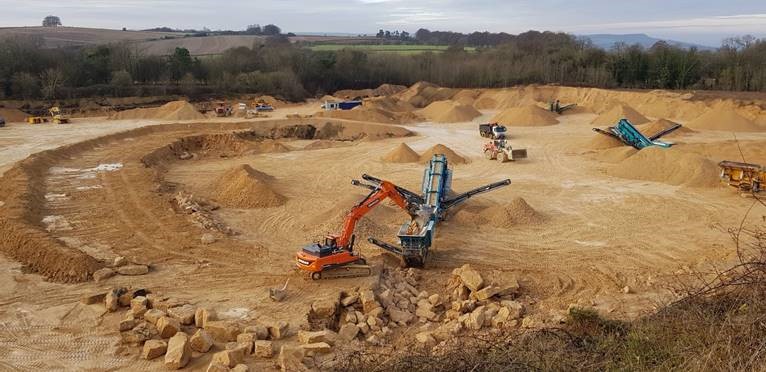
Photograph of Guiting Quarry (Copyright: Paul Keyte, The Johnston Quarry Group)
The Cotswolds Conservation Board has initiated and organised a quarry stakeholder meeting relating to the cluster of eight quarries between Naunton and Toddington in the Cotswolds Area of Outstanding Natural Beauty (AONB). The meeting was held on 29th January at Toddington Village Hall and was attended by 43 participants, including representatives from the quarry operators, parish councils, local authorities and the Conservation Board.
One of the special qualities of the Cotswolds AONB that makes the area so unique and distinctive is the unifying character of the limestone geology, including its use as a building material. However, ensuring a sufficient supply of this building material depends on having a sufficient level of quarrying within the AONB. In addition, there is demand for this stone as a building material outside the AONB, as well as demand for other quarry products, such as aggregate and lime. The challenge is to get the right balance between providing these quarry products and conserving and enhancing the natural beauty of the AONB as a whole.
Getting the right balance is particularly challenging in the Naunton-Toddington area, where eight quarries operate in close proximity to each other and where the associated lorry movements are on minor roads and B roads passing through rural villages and parishes. This close proximity means that the potential cumulative impact of the quarries is a key issue, which needs to be addressed in a holistic way.
The purpose of the quarry stakeholder meeting was to bring together relevant stakeholders to find out if there was consensus on the need for a holistic approach across this quarry cluster and, if so, what this holistic approach might mean in practice. The meeting was run by an independent facilitator to help ensure that it provided a positive forum for discussion and debate.
Speaking about the meeting, John Mills, Planning and Landscape Officer at the Cotswolds Conservation Board, said, “We were delighted that this meeting was so well attended by representatives from key businesses and organisations relating to quarrying in the area. The meeting proved to be a helpful discussion which improved knowledge and understanding around quarrying, and addressed a number of key questions about the issues that arise from it. We also spoke constructively about how we might work on these issues together in the future.”
Paul Keyte, from the Johnston Group (who are involved with two of the quarries in this cluster) said, “We were pleased to participate in the stakeholders meeting about the area around our quarries. We believe all parties would benefit from good engagement helping to understand each other better. We know our quarries are part of the local community and going forward we want to be the best neighbours we can be.”
Temple Guiting Parish Council said, “We welcome the Cotswold Conservation Board’s initiative to bring together relevant stakeholders to review the challenges quarrying can bring to the AONB, particularly to communities in the North Cotswolds. We support local quarrying for the production of local limestone to preserve the heritage of this area, in particular for dry stone walling and building. We look forward to continuing to work with the Board on the next steps, which should give all parties greater understanding of the industry and its improved interactions with our local communities.”
It is anticipated that the next step will be to set up a steering group to take forward the ideas and suggested actions that were discussed at the quarry stakeholder meeting.
ENDS
Notes to editors:
- Please contact Alana Hopkins at hopkins@cotswolds-nl.org.uk / 01451 862 003 for further information or interview opportunities.
- The Cotswolds was designated an Area of Outstanding Natural Beauty (AONB) in 1966 in recognition of its rich, diverse and high quality landscape. www.cotswolds-nl.org.uk
- The Cotswolds Conservation Board’s purposes are to:
-conserve and enhance the natural beauty of the Cotswolds AONB
-increase understanding and enjoyment of the special qualities of the AONB, ensuring that these complement the conservation and enhancement of the area - The Cotswolds AONB is looked after by the Cotswolds Conservation Board – an independent organisation established in 2004 which has 37 members – 15 nominated by local authorities, 8 by parish councils and 14 appointed by the Secretary of State.
- The Cotswolds is the third largest protected landscape in England after the Lake District and Yorkshire Dales National Parks and represents 10% of the total AONB area in the UK. It covers 2,038 square kilometres (790 square miles), stretching from Warwickshire and Worcestershire in the north, through Gloucestershire and Oxfordshire, down to Bath and Wiltshire in the south.
- The land management position statements are for use by local authorities, government agencies, land agents, advisers, land managers, farmers and the public. They, along with the planning and transport position statements are available on the Cotswolds Conservation Board’s website.
- Areas of Outstanding Natural Beauty (AONB), along with National Parks, are considered to be the most special landscapes in the country and belong to an international family of protected areas. There are 38 AONBs in England and Wales, and a further eight in Northern Ireland. For further details, visit: www.landscapesforlife.org.uk. For details of the 13 National Parks in England and Wales visit: www.nationalparks.gov.uk.
- A report of the quarry stakeholder meeting is available from the Cotswolds Conservation Board upon request.
